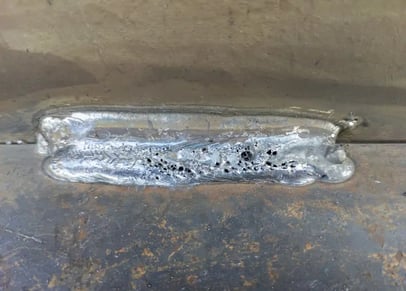What is Porosity in Welding: Comprehending Its Reasons and Enhancing Your Skills
Wiki Article
Unraveling the Secret of Porosity in Welding: Tips for Reducing Issues and Taking Full Advantage Of Quality
In the detailed globe of welding, porosity stays a persistent challenge that can considerably affect the top quality and stability of welded joints. As we dig into the midsts of porosity in welding, uncovering the secrets to its avoidance and control will certainly be vital for professionals seeking to grasp the art of high-grade weldments.Understanding Porosity in Welding
Porosity in welding, a typical issue encountered by welders, refers to the visibility of gas pockets or spaces in the welded product, which can jeopardize the stability and high quality of the weld. These gas pockets are generally caught throughout the welding procedure due to various elements such as incorrect protecting gas, polluted base products, or wrong welding criteria. The formation of porosity can deteriorate the weld, making it susceptible to breaking and rust, inevitably resulting in structural failings.Understanding the origin of porosity is important for welders to effectively prevent its incident. By identifying the significance of preserving correct gas securing, making certain the cleanliness of base materials, and optimizing welding settings, welders can significantly decrease the likelihood of porosity formation. In addition, utilizing techniques like pre-heating the base material, employing appropriate welding techniques, and carrying out complete inspections post-welding can additionally help in decreasing porosity flaws. On the whole, a comprehensive understanding of porosity in welding is necessary for welders to create high-grade and sturdy welds.

Usual Root Causes Of Porosity
When evaluating welding processes for potential high quality concerns, comprehending the common sources of porosity is vital for maintaining weld stability and protecting against architectural failings. Porosity, characterized by the presence of dental caries or spaces in the weld steel, can considerably compromise the mechanical residential or commercial properties of a welded joint. One typical root cause of porosity is improper protecting gas coverage. Poor shielding gas flow rates or improper gas combinations can cause atmospheric contamination, resulting in porosity development.
Another prevalent root cause of porosity is the visibility of dampness and pollutants on the surface area of the base steel or filler material. When welding products are not effectively cleaned or are revealed to high degrees of moisture, the evaporation of these pollutants during welding can develop voids within the weld grain. Additionally, welding at inappropriate parameters, such as excessively high travel rates or currents, can generate excessive disturbance in the weld pool, capturing gases and causing porosity. By dealing with these typical reasons with correct gas shielding, product preparation, and adherence to ideal welding specifications, welders can reduce porosity and enhance the high quality of their welds.
Strategies for Porosity Avoidance
Implementing reliable precautionary procedures is critical in reducing the event of porosity in welding procedures. One technique for porosity avoidance is ensuring correct cleansing of the base steel prior to welding. Pollutants such as oil, oil, corrosion, and paint can cause porosity, so detailed cleaning making use of ideal solvents or mechanical approaches is important. this page
this page Utilizing top notch filler materials and securing gases that are ideal for the base metal and welding procedure can significantly lower the click this link threat of porosity. Additionally, preserving correct welding specifications, such as voltage, current, travel rate, and gas flow rate, is crucial for porosity prevention.
Moreover, using correct welding strategies, such as keeping a constant traveling rate, electrode angle, and arc size, can assist prevent porosity (What is Porosity). Adequate training of welders to ensure they follow ideal practices and high quality control treatments is also important in minimizing porosity defects in welding

Finest Practices for Quality Welds
One key technique is keeping appropriate cleanliness in the welding location. Thoroughly cleaning the work surface and bordering location prior to welding can help alleviate these problems.An additional ideal technique is to carefully select the suitable welding parameters for the particular materials being joined. This consists of setting the appropriate voltage, current, travel rate, and securing gas circulation rate. Correct criterion choice ensures ideal weld penetration, fusion, and total top quality. Moreover, using premium welding consumables, such as electrodes and filler metals, can substantially influence the last weld quality. Purchasing premium consumables can result in stronger, extra long lasting welds with less issues. By adhering to these ideal methods, welders can regularly create high-quality welds that fulfill market criteria and exceed consumer assumptions.
Relevance of Porosity Control
Porosity control plays a crucial function in ensuring the integrity and high quality of welding joints. Porosity, identified by the presence of dental caries or gaps within the weld metal, can considerably compromise the mechanical buildings and structural honesty of the weld. navigate to this website Excessive porosity deteriorates the weld, making it much more vulnerable to fracturing, rust, and overall failure under operational tons.Efficient porosity control is important for keeping the preferred mechanical properties, such as stamina, ductility, and durability, of the welded joint. What is Porosity. By minimizing porosity, welders can improve the total top quality and dependability of the weld, making certain that it meets the performance requirements of the intended application
Moreover, porosity control is vital for attaining the wanted visual appearance of the weld. Excessive porosity not only compromises the weld however likewise interferes with its aesthetic appeal, which can be essential in markets where aesthetic appeals are essential. Appropriate porosity control strategies, such as making use of the right shielding gas, managing the welding specifications, and making sure correct sanitation of the base products, are important for generating top quality welds with very little problems.

Final Thought
In conclusion, porosity in welding is an usual flaw that can jeopardize the high quality of the weld. It is important to control porosity in welding to guarantee the integrity and toughness of the final product.Report this wiki page